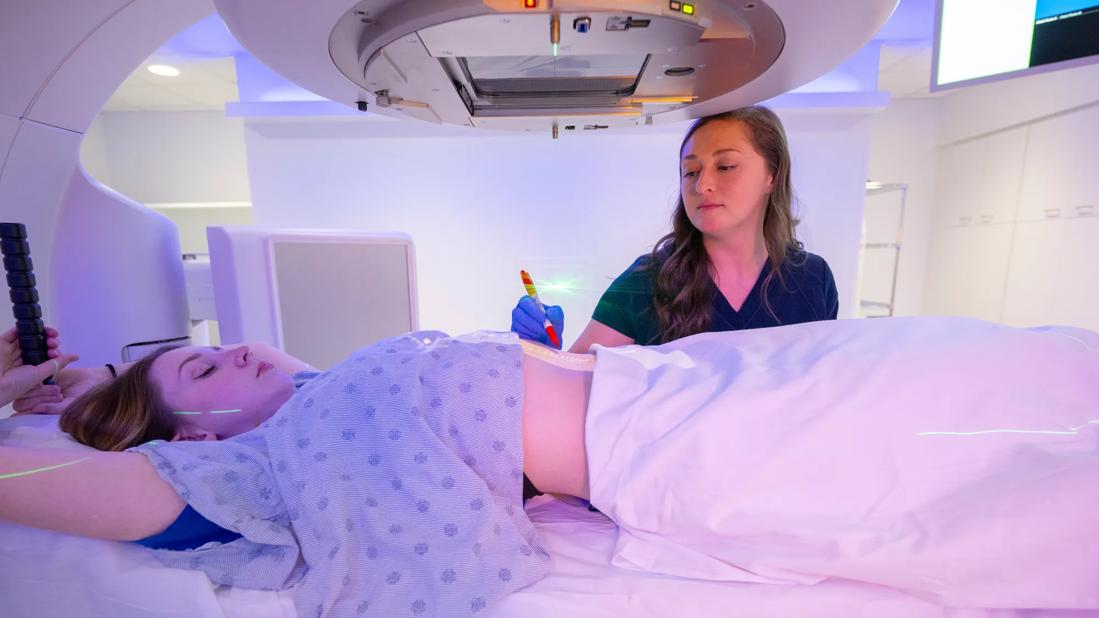Dose and neutrophil-to-lymphocyte ratio are key factors

Stereotactic body radiation therapy (SBRT) is increasingly used to treat pediatric patients with recurrent or metastatic sarcomas. New research by Cleveland Clinic investigators points to ways to optimize its effects and underscores its safety.
Advertisement
Cleveland Clinic is a non-profit academic medical center. Advertising on our site helps support our mission. We do not endorse non-Cleveland Clinic products or services. Policy
The findings, contained in three abstracts presented at the American Society for Radiation Oncology (ASTRO) 2021 Annual Meeting, focus on:
“We wanted to go beyond our previous retrospective studies which confirmed the safety and tolerability of SBRT, and identify factors that might improve outcomes,” says co-author Erin Murphy, MD, a pediatric radiation oncologist at Cleveland Clinic. “We found that local control of metastatic sarcoma was significantly improved with a biologically effective dose of at least 95 Gy for radiosensitive histologies and that neutrophil-to-lymphocyte ratio before and after treatment was predictive of survival in patients with metastasis.”
SBRT delivers focused high-dose radiotherapy over one to five treatments. With the technology, normal tissues can be spared while the biologic effectiveness of radiotherapy is increased. Because the total course of therapy is limited to no more than one week, the impact on patients’ quality of life is less than with traditional radiotherapy.
Recent studies of dosage and immune parameters were based on analysis of registry data from 42 patients treated with SBRT at Cleveland Clinic from 2014 to 2020. In the third report, the researchers looked at the safety of SBRT for sarcoma in extremities among 16 patients with a total of 37 metastases treated from 2015 to 2020.
Advertisement
A Kaplan–Meier analysis and univariate and multivariable Cox proportional hazard models were used for the dose-finding and NTLR studies. For the study on extremities, patient characteristics, histology, treatment details and toxicities were analyzed.
All of the patients treated with SBRT were heavily pretreated with systemic therapies and sometimes radiotherapy as well. Of the 138 lesions studied, 62 were categorized as radiosensitive and 75 as radioresistant. For all tumors, local control rates were 66.7% at one year and 50.2% at two years. A dose cutoff for improved local control was found at a BED of 95 Gy. Local control at one year was 75% for lesions that received ≥ 95 Gy BED versus 46.2% for those that received < 95 Gy BED (P = 0.01). It remained significant for tumors that were radiosensitive (P = 0.013) but not for those that were radioresistant (P = 0.25).
Looking at immune parameters in the same patients, the authors found that the median NTLRs for controlled lesions before and after SBRT were 5.05 and 4.79, respectively. Median NTLRs for failed lesions before and after SBRT were 3.31 and 3.51, respectively, and at local failure were 5.62. The change in median NTLR was significant within the failed group (P = 0.027) but not within the controlled group (P = 0.30). On both univariate and multivariable analyses, NTLR before SBRT was associated with poorer survival (HR = 1.11, 95% CI: 1.04-1.19 and HR = 1.12, 95% CI: 1.03-1.21, respectively).
The optimal NTLR cut point by survival ROC analysis was 5. The one-year survival rate in patients with an NTLR above 5 at time of SBRT was 47.6% versus 63% for those with an NTLR below 5.
Advertisement
“Because the data we analyzed are retrospective, these studies are hypothesis-generating,” says Dr. Murphy. “However, they suggest that to optimize local control of sarcoma in patients using SBRT, we need to aim for a BED of 95 Gy and that NTLR over time may be a significant predictor of local control.”
The third analysis showed that SBRT was well-tolerated with minimal acute or late toxicity in patients who had osteosarcoma, Ewing sarcoma, synovial sarcoma or another type of lesion. Of the 37 lesions represented, 28 were in weight-bearing lower extremities of the pelvis and nine in upper extremities.
At median follow-up of 10 months, none of the patients had experienced fractures or grade ≥ 3 acute or late toxicities. Only three patients had acute grade 2 toxicity consisting of radiation dermatitis, and two patients had acute grade 1 toxicity of fatigue.
“Sarcomas, in general, are more resistant to radiation, so we need to be aggressive with radiotherapy to achieve durable lasting control,” says Dr. Murphy. “Our experience with SBRT, as documented in the new analyses, shows that we can use it to treat these cancers effectively with minimal impact on quality of life for our patients.”
Advertisement
Advertisement

Large retrospective study suggests DOACs are safe, effective alternative to low-molecular-weight heparin in complex patient population

Care paths and research initiatives aim to answer unmet clinical needs

Study shows high rate of hematologic responses, low rate of disease progression

Bispecific antibody bridging therapy deepens durability of BCMA CAR T-cell therapy without overlapping toxicities in patients with relapsed/refractory multiple myeloma

Phase 2 study brings pivotal advances in treatment efficacy and safety for the most challenging-to-treat population

Patient with quadruple refractory multiple myeloma achieves complete response with cell therapy

Distinct baseline immune profiles can predict response and resistance to different types of CAR-T cells.

National Blood Clot Alliance collaborates with faith-based organizations on first-of-its-kind church bus tour